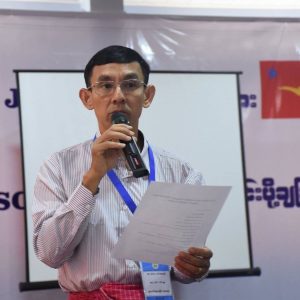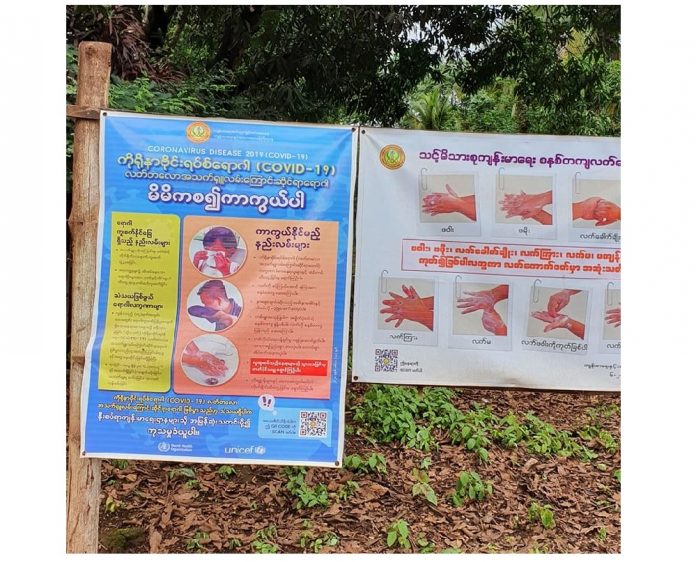Myanmar is among the many governments globally that are being forced to confront the economic impacts of the COVID-19 pandemic.
After the Myanmar government formed the national-level Central Committee for Prevention, Control, and Treatment of COVID-19 and the COVID-19 Economic Relief Plan Working Committee, they announced their own COVID-19 Economic Relief Plan (CERP).
The CERP is comprised of seven goals, 10 strategies, 36 action plans, and 76 action points. This includes lifting restrictions on the private sector to improve micro-level business projects, investment, trading, and banking. It also involves the provision of assistance to laborers, working-class people and their families, and funds to the health system and businesses hit by COVID-19.

It also allocates significant funds to private banks and private companies—including those working in the controversial sectors of energy and construction—to resume operations.
In order to fund and implement the CERP, Myanmar’s government expects to borrow US$2 billion from international loan providers. According to the deputy minister of finance, the government will spend the equivalent of 5 percent of its GDP on the initiative, which is US$3.5 billion.
Concerns over Myanmar’s CERP
Two major concerns around the CERP are the lack of a clear implementation strategy and the huge amount of borrowed funds it requires.
Parliamentarians have called on the government to outline the details of the CERP for Myanmar’s legislature. In addition, parliamentarians and scholars point out that Myanmar loans could end up being an additional burden on the country.
One feature of the CERP is relief for the private sector through interest rate reduction on new loans from banks, an increase in the availability of loans, and reduced restrictions on banks and bank reserves. Yet private banks in Myanmar have a documented history of large scale defaults by companies unable to repay these loans—known in the investment world as Non-Performing Loans (NPL).
At the beginning of 2019, Myanmar’s private banks held an estimated US$1.5 billion of NPLs.
Due to the lack of governance and oversight of banks and financial institutions in Myanmar, as well as the prevalence of the black market jade and drug trade embedded in Myanmar’s financial system, the EU placed the country on its global money laundering blacklist in 2020.
According to Global Witness, Myanmar’s illicit jade industry brought in $31 billion in 2014 alone. Unsurprisingly, these funds were not distributed for the benefit of society and instead ended up in the pockets of a handful of people, likely military officials, and cronies.
Myanmar’s private banking sector also lacks transparency and includes institutions that have been blacklisted internationally for their murky financial practices and ties to the military.
Any funds that the government provides to these institutions through the CERP will have to be paid back to the lenders by Myanmar’s taxpayers. Questions are being raised about whether the aims and objectives of the government’s economic relief plan which is to help working people and their families, will be fulfilled if these funds go into Myanmar’s private banking sector, given such lack of transparency, corruption, and poor governance.
Limited Geographic Distribution of CERP Funds
COVID-19 has had a particularly negative impact on local livelihoods in ethnic states, particularly in conflict-affected areas. Chapters 2.1.7, 3.1.2, and 4.1.2 of the CERP outline the need to provide assistance to farmers working on small agricultural projects, to create jobs for unemployed laborers and returning migrants from neighboring countries, and to provide food and basic assistance for working-class people in need.
Myanmar’s existing loan practices are not in line with this promise, so it is unclear how the loans generated through the CERP would be distributed differently. In 2018 some 88 percent of total loans from private banks were given to businesses involved in trading, construction, and services and while less than 1% was given for private family house loans.
In 2019 more than 90 percent of total private bank loans in Myanmar never reached people in ethnic states; approximately 80 percent went to businesses and business people in Yangon, and 12 percent to those based in Mandalay.
The CERP does not specify what percentage of its borrowed funds would be allocated to the country’s ethnic states, or regions outside of Yangon and Mandalay. In keeping with previous practices, it is likely that the funds will be spent largely in these two major urban areas.
The CERP and Conflict
The Myanmar government hopes to “fast-track” five mega-development projects before the end of 2020, a goal outlined in the CERP’s Chapter 2.3, indicating that the administration would use the plan to bypass investigation and public input in order to push the initiatives ahead. This would involve forgoing required Environment and Social Impact Assessments, and risk endorsing and pursuing projects that are not welcomed by the people or viable.
Given such mega-projects in ethnic regions have consistently had negative impacts on livelihoods and cultures of ethnic populations and have exacerbated the ongoing armed conflict, these planned mega-projects can exacerbate the conflict not only in war-torn areas but also in currently non-conflict affected areas. These initiatives could include hydropower dams, special economic zones, and mining projects. Since the CERP states a plan to advance renewable energy, it is possible that the construction of widely opposed large scale hydropower projects—including the Myitsone dam on the Irrawaddy River or the Mong Ton dam on the Salween River—could resume, creating conflict between the government and locals.
In early June, while COVID-19 continued to spread globally, the government allowed Chinese company Guangdong Rising H.K. Ltd. to extract copper and gold from 185,000 acres in the Wontho mountain range in Sagaing Region. Locals opposed the move.
Civil society organizations, particularly in Karenni ethnic areas, have issued demands to the government not to pursue mega-development projects given the current political situation, and to especially avoid implementing these initiatives amid the COVID-19 pandemic.
Conclusion
The centralization of power and mismanagement of natural resources and land are major contributors to the civil war in Myanmar. Peace and stability in the country depend on decentralization, systemic change, and addressing the mismanagement of land and natural resources. If we can solve these problems, peace will be restored in the country, and the country would be able to overcome the COVID-19 crisis with unity.
State Counsellor Daw Aung San Suu Kyi has stated that the country would respond to the COVID-19 crisis with a wide range of cooperative methods and would implement a coordinated national response to recover Myanmar’s economy. However, by looking at the implementation of the CERP, only government ministries are implementing the CERP after being assigned to do so by a central powerhouse. Any cooperation between the central government and state and regional governments, ethnic armed organizations, ethnic political parties, or CSOs has not been seen.
The COVID-19 pandemic creates both crises and opportunities. It is said because of COVID-19, we are better able to scrutinize and review all of the situations unfolding throughout the country. The COVID-19 crisis can potentially create a new path for Myanmar. Optimistically, the actions in response to COVID-19 could contribute to the improvement of the health and the social welfare systems in the country. If we see the COVID-19 crisis as an opportunity, the implementation of the country’s response to it could lead to the building of a new federal union, and the initiation of a process of genuine national reconciliation. We will see whether the CERP will fulfill these objectives or whether it will create an escalation of conflict and strengthen existing practices of centralization.
Nai Banyar Mon is the program director of the Federal Affairs and Policy Center.
- References:
- https://www.hrw.org/news/2020/03/30/us-economic-relief-package-shortchanges-workers
- https://www.moi.gov.mm/moi:eng/?q=news/28/04/2020/id-21511
- https://www.mmtimes.com/news/government-expects-2-billion-international-aid-covid-19-response-plan.html
- https://burma.irrawaddy.com/news/2020/05/26/223396.html
- https://burma.irrawaddy.com/news/2020/05/27/223475.html
- https://www.rfa.org/burmese/program_2/china-loan-crisis-06092020064610.html
- https://www.krungsri.com/bank/getmedia/a51f8424-fba9-4cad-b8b4-0c55eeb66cbe/RI_Myanmar_Banking_Stability_191118_EN.aspx
- https://www.mmtimes.com/news/eu-puts-myanmar-money-laundering-blacklist.html
- https://resourcegovernance.org/sites/default/files/documents/2017-resource-governance-index.pdf
- https://www.globalwitness.org/en/campaigns/oil-gas-and-mining/myanmarjade/
- https://burma.irrawaddy.com/business/2020/06/04/224000.html
- https://www.bnionline.net/mm/news-73289
- https://www.cbm.gov.mm/sites/default/files/policy_relationship/2019_volume_iii_23-6-2020.pdf
- Aung Thu Nyein – The changing of the role of the nation due to COVID-19 crisis (Burmese)
- Min Zin- COVID-19 crisis could support Myanmar’s transition ( Burmese)

